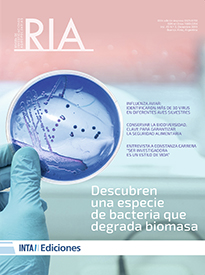Ver ítem
- xmlui.general.dspace_homeCentros Regionales y EEAsCentro Regional Catamarca - La RiojaEEA CatamarcaArtículos científicosxmlui.ArtifactBrowser.ItemViewer.trail
- Inicio
- Centros Regionales y EEAs
- Centro Regional Catamarca - La Rioja
- EEA Catamarca
- Artículos científicos
- Ver ítem
Estrategias de mitigación de emisiones de gases de efecto invernadero en sistemas ganaderos bovinos extensivos del sur de San Luis, Argentina. Estudio de casos
Resumen
La ganadería bovina es una de las principales fuentes de emisiones antropogénicas de gases de efecto invernadero (GEI). A nivel internacional, regional y nacional existe una gran diversidad de estudios relacionados con la búsqueda de estrategias de mitigación de esos gases. El objetivo de este trabajo fue analizar el efecto de la aplicación de tecnologías estratégicas sobre las emisiones de GEI en sistemas productivos ganaderos típicos de la región sur de
[ver mas...]
La ganadería bovina es una de las principales fuentes de emisiones antropogénicas de gases de efecto invernadero (GEI). A nivel internacional, regional y nacional existe una gran diversidad de estudios relacionados con la búsqueda de estrategias de mitigación de esos gases. El objetivo de este trabajo fue analizar el efecto de la aplicación de tecnologías estratégicas sobre las emisiones de GEI en sistemas productivos ganaderos típicos de la región sur de San Luis. Para ello se analizaron 6 casos de estudios en sus características actuales (SPA) y se plantearon y simularon dos propuestas mejoradoras de sus sistemas productivos (SPM1 y SPM2), se estimaron emisiones de CH4 por fermentación entérica y N2O de suelos gestionados. Se caracterizaron las emisiones y se realizó una comparación de emisiones de GEI de los sistemas entre sus tres estados (SPA, SPM1 y SPM2) a través de un ANOVA. Las “emisiones por ternero” fueron significativamente superiores (P<0,001) en el SPA que en los SPM1 y SPM2 emitiendo un 33% y un 36% menos de emisiones que el SPA. En el caso de las “emisiones por kg de peso vivo vendido” las emisiones fueron significativamente superiores en el SPA respecto al SPM2 emitiendo este un 25% menos. La aplicación de nuevas tecnologías no solamente disminuye las emisiones, sino que mejora la producción de esos sistemas. Por lo que, los resultados demuestran que la aplicación de prácticas de mejora en los sistemas de producción (ajuste de carga animal, reordenamiento del rodeo, manejo del pasto, sanidad animal, división de potreros) tienen un considerable potencial para mitigar las emisiones de GEI en estos sistemas.
[Cerrar]
Cattle farming are one of the main sources of anthropogenic emissions of greenhouse gases (GHG). At the international, regional and national levels, there is a great diversity of studies related to the search for mitigation strategies for these gases. The objective of this work was to analyze the effect of the application of strategic technologies on GHG emissions in typical livestock production systems of the southern region of San Luis. To do this, six
[ver mas...]
Cattle farming are one of the main sources of anthropogenic emissions of greenhouse gases (GHG). At the international, regional and national levels, there is a great diversity of studies related to the search for mitigation strategies for these gases. The objective of this work was to analyze the effect of the application of strategic technologies on GHG emissions in typical livestock production systems of the southern region of San Luis. To do this, six case studies were analyzed in their current characteristics (SPA) and two proposals were raised to improve their production systems (SPM1 and SPM2), estimating emissions by CH4 through enteric fermentation and N2O of the managed soils. The GHG emissions were characterized and comparison was made of the systems between their three states (SPA, SPM1 and SPM2) was conducted through an ANOVA. The “emissions per calf” were significantly higher (P <0.001) in the SPA than in the SPM1 and SPM2, emitting 33% and 36% less emissions than the SPA. In the case of “emissions per kg of live weight sold”, emissions were significantly higher in the SPA compared to SPM2, emitting 25% less. The application of technologies not only reduce emissions but also improve the production of these systems. Therefore, the results show that the application of management practices in the production systems (animal load adjustment, herd rearrangement, pasture management, animal health, division of paddocks) have considerable potential to mitigate emissions of GHG in these systems.
[Cerrar]

Autor
Nieto, Maria Isabel;
Frasinelli, Carlos Alberto;
Frigerio, Karina Laura;
Reine Viñales, Ramón;
Barrantes Díaz, Olivia;
Fuente
RIA 45 (3) : 404-411 (Diciembre 2019)
Fecha
2019-12
Editorial
Ediciones INTA
ISSN
0325-8718
1669-2314
1669-2314
Formato
pdf
Tipo de documento
artículo
Palabras Claves
Derechos de acceso
Abierto
 Excepto donde se diga explicitamente, este item se publica bajo la siguiente descripción: Creative Commons Attribution-NonCommercial-ShareAlike 2.5 Unported (CC BY-NC-SA 2.5)
Excepto donde se diga explicitamente, este item se publica bajo la siguiente descripción: Creative Commons Attribution-NonCommercial-ShareAlike 2.5 Unported (CC BY-NC-SA 2.5)


